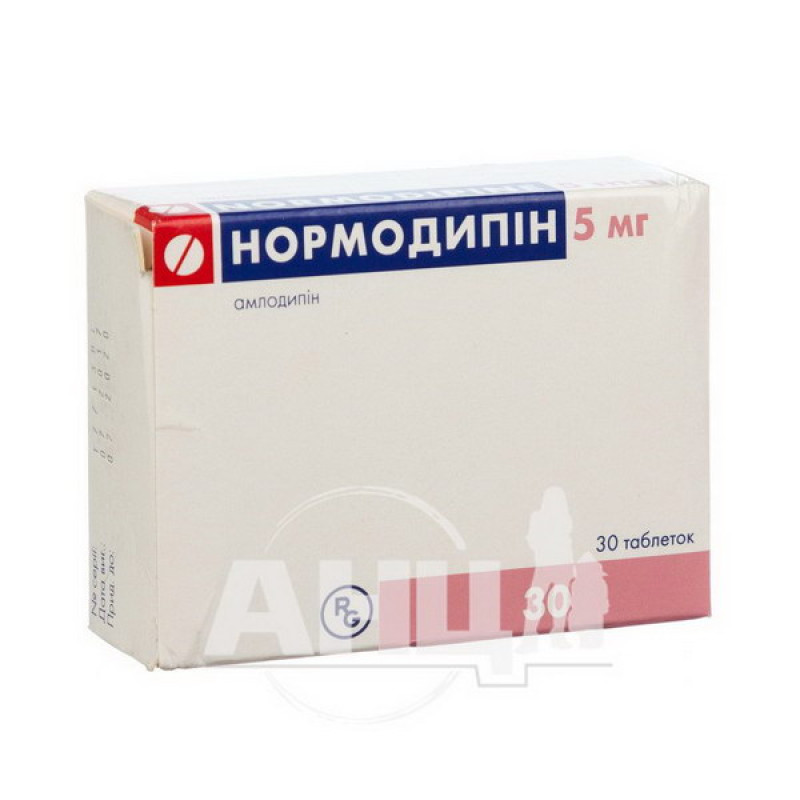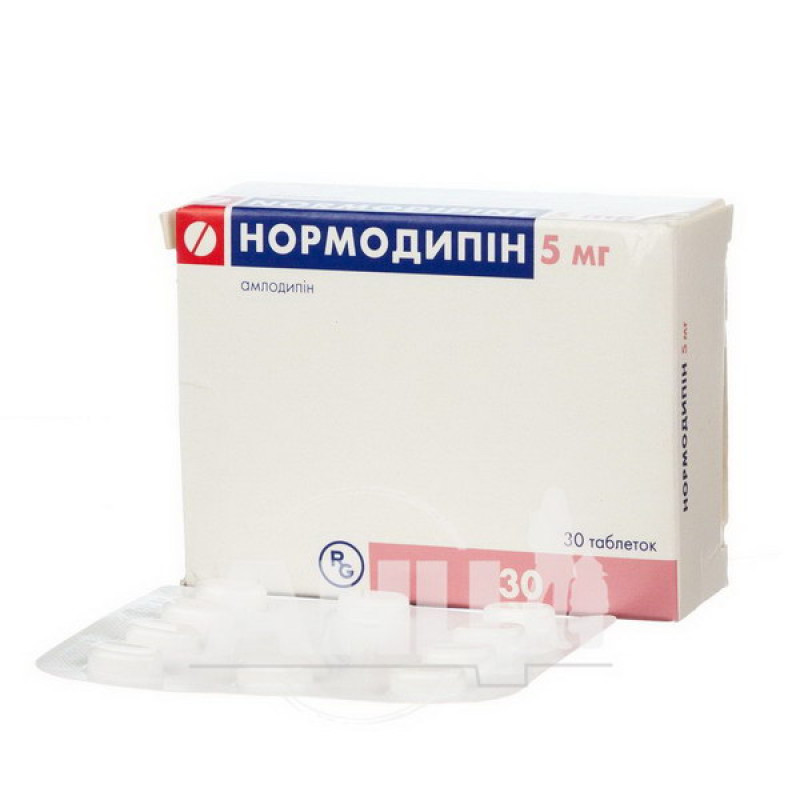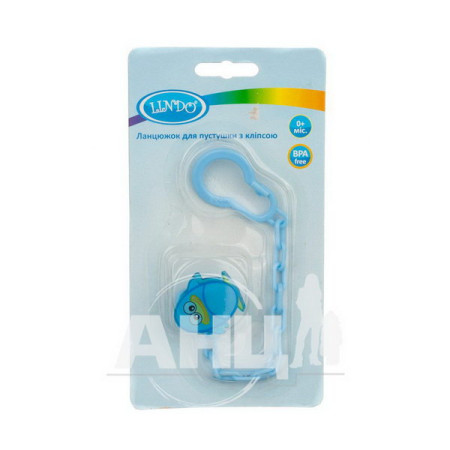Normodipine tablets 5 mg No. 30

Instructions Normodipine tablets 5 mg No. 30
Composition
active ingredient: amlodipine;
1 tablet contains respectively:
5 mg amlodipine (as 6.944 mg amlodipine besylate);
excipients: magnesium stearate, sodium starch glycolate (type A), calcium hydrogen phosphate anhydrous, microcrystalline cellulose.
Dosage form
Pills.
Main physicochemical properties: 5 mg tablets: white or almost white biconvex tablets of oblong-round shape with engraving 5 on one side.
Pharmacotherapeutic group
Selective calcium antagonists with a predominant effect on blood vessels. ATC code C08C A01.
Pharmacological properties
Pharmacodynamics
Pharmacotherapeutic group: "slow" calcium channel blockers, selective "slow" calcium channel blocker with predominant vascular action.
Amlodipine, a dihydropyridine derivative, inhibits the transmembrane influx of calcium ions (a blocker of "slow" calcium channels or calcium ion antagonist); it also blocks the transmembrane influx of calcium ions into myocardial and vascular smooth muscle cells.
The mechanism of hypotensive action of amlodipine is due to a direct relaxing effect on vascular smooth muscle. The exact mechanism of action of amlodipine in angina has not been definitively established, but amlodipine reduces ischemia by two pathways described below:
Amlodipine dilates peripheral arterioles and thus reduces the total peripheral vascular resistance (afterload), which requires the work of the heart to overcome. Since the heart rate does not change, the reduction in the workload on the heart reduces energy consumption and myocardial oxygen demand.
The mechanism of action of amlodipine probably also involves dilation of the main coronary arteries and coronary arterioles in both intact and ischemic areas of the myocardium. This dilation increases the supply of oxygen to the myocardium in patients with coronary artery spasm (Prinzmetal's angina or variant angina).
In patients with arterial hypertension, the use of the drug 1 time per day provides a clinically significant reduction in blood pressure for 24 hours in both the supine and standing positions. Due to the slow onset of action of amlodipine, acute arterial hypotension is usually not observed.
In patients with angina pectoris, a single daily dose of the drug increases the total time of physical exertion, the time to the onset of angina pectoris, and the time to 1 mm of ST-segment depression. The drug reduces the frequency of angina attacks and reduces the need for nitroglycerin.
Amlodipine is not associated with any adverse metabolic effects or changes in plasma lipid levels and can be used in patients with asthma, diabetes, and gout.
Pharmacokinetics
Absorption, distribution and binding to blood plasma proteins.
Amlodipine is well absorbed after oral administration in therapeutic doses. The maximum concentration of the drug in the blood is noted after 6-12 hours. Its absolute bioavailability is approximately 64-80%. The volume of distribution is approximately 21 l/kg. Approximately 97.5% of amlodipine circulating in the blood binds to plasma proteins.
Food intake does not affect the bioavailability of amlodipine.
Metabolism/excretion.
The terminal half-life is approximately 35-50 hours, which allows once-daily dosing. Amlodipine is extensively metabolized in the liver to inactive metabolites; the drug is excreted in the urine as parent compound (10%) and metabolites (60%).
Use in case of impaired liver function.
Limited clinical data are available on the use of amlodipine in patients with hepatic impairment. Patients with hepatic impairment have reduced creatinine clearance, resulting in an increase in AUC of approximately 40-60% and a prolongation of the elimination half-life.
Use in elderly patients.
The time to reach maximum plasma concentrations of amlodipine is similar in young and elderly patients. However, clearance of amlodipine is reduced in elderly patients, resulting in increased AUC and half-life in these patients. Increased AUC and half-life are also observed in patients with congestive heart failure.
Use in children and adolescents.
There is a large interindividual variability. Data in children under 6 years of age are limited.
Indication
Arterial hypertension. Chronic stable angina. Vasospastic angina (Prinzmetal's angina).
Contraindication
Amlodipine is contraindicated in patients with the following conditions:
Hypersensitivity to amlodipine, dihydropyridine derivatives or any of the other ingredients of the drug; severe arterial hypotension; shock (including cardiogenic shock); obstruction of the left ventricular outflow tract (e.g., severe aortic stenosis); hemodynamically unstable heart failure after acute myocardial infarction.
Interaction with other medicinal products and other types of interactions
Effect of other drugs on amlodipine.
Concomitant use of amlodipine with strong or moderate CYP3A4 inhibitors (protease inhibitors, azole antifungals, macrolides such as erythromycin or clarithromycin, verapamil or diltiazem) may lead to a significant increase in amlodipine concentrations, which may also lead to an increased risk of hypotension. The clinical manifestations of these pharmacokinetic abnormalities may be more pronounced in elderly patients. Therefore, clinical monitoring and dose adjustment may be necessary.
Clarithromycin is a CYP3A4 inhibitor. There is an increased risk of hypotension in patients receiving clarithromycin and amlodipine concomitantly, therefore close monitoring is recommended in such patients.
CYP3A4 inducers.
When used concomitantly with known CYP3A4 inducers, amlodipine plasma concentrations may fluctuate. For this reason, blood pressure should be monitored and the dose adjusted during and after concomitant use, especially with strong CYP3A4 inducers (e.g. rifampicin, St. John's wort [Hypericum perforatum] preparations).
Concomitant use of amlodipine and consumption of grapefruit or grapefruit juice is not recommended, as this may lead to increased bioavailability of amlodipine in some patients, which in turn may increase the hypotensive effect.
Dantrolene (infusion): In laboratory animals, cases of ventricular fibrillation and cardiovascular failure, accompanied by hyperkalemia, with fatal outcome and collapse, have been observed with the use of verapamil and intravenous administration of dantrolene. Due to the risk of hyperkalemia, the concomitant use of dantrolene and slow calcium channel blockers, including amlodipine, should be avoided in patients predisposed to malignant hyperthermia, as well as in the treatment of malignant hyperthermia.
The effect of amlodipine on other drugs.
Amlodipine enhances the hypotensive effect of other drugs that have antihypertensive effects and are used to lower blood pressure.
Tacrolimus.
There is a risk of increased blood levels of tacrolimus when co-administered with amlodipine, but the pharmacokinetic mechanism of this interaction has not been fully established. To avoid tacrolimus toxicity, regular monitoring of tacrolimus blood levels and, if necessary, dosage adjustment are required when amlodipine is co-administered.
Cyclosporine.
In renal transplant patients, variable increases in residual cyclosporine concentrations (mean 0-40%) have been observed. In renal transplant patients receiving amlodipine, monitoring of cyclosporine concentrations should be considered and, if necessary, a reduction in the cyclosporine dose.
Simvastatin: Co-administration of multiple doses of amlodipine 10 mg with simvastatin 80 mg resulted in a 77% increase in simvastatin concentrations compared to simvastatin monotherapy. It is recommended that the dose of simvastatin be limited to 20 mg daily in patients taking amlodipine.
mTOR inhibitors (mammalian target of rapamycin).
mTOR inhibitors such as sirolimus, temsirolimus and everolimus are substrates of CYP3A. Amlodipine is a weak inhibitor of CYP3A. When amlodipine is used concomitantly with mTOR inhibitors, it may potentiate the effects of the latter.
Sildenafil.
A single dose of 100 mg of sildenafil in patients with essential hypertension did not affect the pharmacokinetics of amlodipine. When amlodipine and sildenafil were used simultaneously as combination therapy, each drug exhibited an independent hypotensive effect.
Other medicines.
Amlodipine does not affect the pharmacokinetics of atorvastatin, digoxin, or warfarin.
Ethanol (alcohol).
Single and multiple doses of 10 mg amlodipine had no significant effect on the pharmacokinetics of ethanol.
Co-administration of amlodipine with cimetidine had no effect on the pharmacokinetics of amlodipine.
Co-administration of aluminum/magnesium preparations (antacids) with a single dose of amlodipine had no significant effect on the pharmacokinetics of amlodipine.
Laboratory tests.
The effect on laboratory test results is unknown.
Application features
The safety and efficacy of amlodipine in hypertensive crisis have not been established.
Patients with heart failure.
Amlodipine should be used with caution in this category of patients.
In studies involving patients with heart failure (NYHA functional class III-IV), it was found that in the group receiving amlodipine, compared with the placebo group, the number of cases of pulmonary edema increased, but this was not associated with a worsening of the course of heart failure.
Slow calcium channel blockers, including amlodipine, should be used with caution in patients with congestive heart failure because they increase the risk of cardiovascular complications and mortality.
The half-life of amlodipine and AUC values are increased in patients with impaired hepatic function; recommended doses in such patients have not been established. Treatment with amlodipine should be initiated at the lowest dose and caution should be exercised when increasing the dose. In patients with severe hepatic impairment, dose titration should be slow and under close medical supervision.
Use in elderly patients
Dose increases for elderly patients should be carried out with caution (see sections “Dosage and Administration” and “Pharmacokinetics”).
Use in patients with renal impairment.
In this group of patients, amlodipine can be used in normal doses. Changes in plasma concentrations of amlodipine do not correlate with the degree of renal impairment. Amlodipine is not removed by hemodialysis.
Ability to influence reaction speed when driving vehicles or other mechanisms
Amlodipine may have some influence on the ability to drive or use machines. If a patient taking amlodipine experiences dizziness, headache, fatigue or nausea, they may affect the speed and quality of reactions. It is recommended to exercise caution at the initial stage of treatment.
Use during pregnancy or breastfeeding
Pregnancy: The safety of amlodipine for use in pregnant women has not been established.
Use during pregnancy is recommended only if there is no safer alternative, or if the mother's condition poses a greater risk to the mother and fetus than the treatment. Reproductive toxicity has been observed in animals at high doses.
Breastfeeding. Amlodipine is excreted in human milk. The proportion of the maternal dose received by the infant was estimated to be 3-7% interquartile range, with a maximum of 15%. The effects of amlodipine on the infant are unknown. A decision on whether to continue/discontinue breast-feeding or to continue/discontinue therapy with amlodipine should be made taking into account the benefit of breast-feeding for the child and the benefit of therapy for the mother.
Fertility: Reversible biochemical changes in the heads of sperm have been reported in some patients receiving calcium channel blockers. Clinical data on the possible effects of amlodipine on fertility are limited.
Method of administration and doses
Doses
Adults
In the case of hypertension and angina pectoris, the usual starting dose is 5 mg once daily. Depending on the individual patient's response to treatment, this dose may be increased to a maximum dose of 10 mg daily.
In patients with arterial hypertension, Normodipine is used in combination with a thiazide diuretic, an alpha-blocker, a beta-blocker or an angiotensin-converting enzyme inhibitor. In patients with angina pectoris who do not respond to treatment with nitrates and/or adequate doses of beta-blockers, Normodipine can be used as monotherapy or in combination with other antianginal agents.
In case of simultaneous administration of the drug with thiazide diuretics, beta-blockers and ACE inhibitors, dose adjustment is not required.
Special patient groups
Children and adolescents aged 6 to 17 years who suffer from hypertension
The recommended initial dose for the treatment of hypertension in patients aged 6 to 17 years is 2.5 mg per day (in this case, another drug should be used); if blood pressure control is not achieved after 4 weeks of use of the drug, the dose can be increased to 5 mg per day. The use of doses exceeding 5 mg per day for the treatment of pediatric patients has not been studied (see section "Pharmacokinetics").
Elderly patients.
Normodipine, used in similar doses, is equally well tolerated by both young and elderly patients. The usual treatment regimen is recommended for elderly patients, but dose increases should be carried out with caution (see sections "Special instructions for use" and "Pharmacokinetics").
Liver dysfunction.
Recommended doses for patients with mild or moderate hepatic impairment have not been established. Dose selection should be carried out with caution; treatment should be initiated at the lowest recommended dose (see sections 4.4 and 5.2). The pharmacokinetics of amlodipine in patients with severe hepatic impairment have not been studied. Treatment of patients with severe hepatic impairment should be initiated at the lowest dose of amlodipine; dose titration should be gradual.
Kidney dysfunction.
Changes in plasma concentrations of amlodipine do not correlate with the degree of renal impairment, therefore, the use of normal doses is recommended in such patients. Amlodipine is not removed by hemodialysis.
Method of application
Tablets for oral administration.
This medicine is not available in a 2.5 mg strength. Normodipine 5 mg tablets are not intended to be split in half to obtain a 2.5 mg dose.
Children
Use for children aged 6 and over.
The effect of amlodipine on blood pressure in patients under 6 years of age is unknown.
Overdose
Symptoms: Available data indicate that significant overdose may lead to excessive peripheral vasodilation with possible development of reflex tachycardia. Cases of severe and persistent arterial hypotension, including the development of shock and death, have been described.
Treatment.
Clinically significant hypotension caused by amlodipine overdose requires active measures aimed at supporting the function of the cardiovascular system, including raising the lower extremities in an elevated position, monitoring heart and lung function, and controlling circulating blood volume and diuresis.
To restore vascular tone and normalize blood pressure, in the absence of contraindications, it is possible to use vasoconstrictor drugs. To eliminate the effects of calcium channel blockade, intravenous calcium gluconate should be administered.
In some cases, gastric lavage may be effective. Administration of activated charcoal to healthy volunteers at a dose of 10 mg immediately or within 2 hours after taking amlodipine resulted in a significant decrease in the absorption of the drug. Since amlodipine is highly bound to serum proteins, hemodialysis is of little use.
Adverse reactions
The most frequently observed adverse reactions during treatment were: drowsiness, dizziness, headache, palpitations, hot flashes, abdominal pain, nausea, leg swelling, edema, and fatigue.
The list of adverse reactions is given in the table below.
During treatment with amlodipine, undesirable effects were observed, the frequency of which is defined as: very common (≥1/10); common (≥1/100 and <1/10); uncommon (≥1/1000 and <1/100); rare (<1/10000), frequency unknown (cannot be estimated from the available data).
| Frequency of adverse reactions | ||||||
Organ system class | Very common | Frequent | Infrequent | See you later. noki | Rare | Frequency unknown |
| Blood and lymphatic system disorders | Leukocytopenia, thrombocytopenia | |||||
| On the part of the immune system | Allergic reactions | |||||
| Metabolism and nutrition | Hyperglycemia | |||||
| Mental disorders | Insomnia, mood changes (including anxiety), depression | Confusion of consciousness | ||||
| From the nervous system | Drowsiness, dizziness, headache (mainly at the beginning of treatment) | Tremor, dysgeusia (taste disturbance), syncope, hypoesthesia, paraesthesia | Hypertonicity, peripheral neuropathy | Extrapyramidal disorders | ||
| From the organs of vision | Visual disturbances (including diplopia) | |||||
| From the side of the organs of hearing and labyrinth | Tingle | |||||
| From the heart | Increased heartbeat | Arrhythmia (including bradycardia, ventricular tachycardia, and atrial fibrillation) | Myocardial infarction | |||
| From the vascular side | Tides | Arterial hypotension | Vasculitis | |||
| Respiratory, thoracic and mediastinal disorders | Dyspnea | Cough, rhinitis | ||||
Gastrointestinal tract | Abdominal pain, nausea, dyspepsia, intestinal motility disorders (including diarrhea and constipation) | Vomiting, dry mouth | Pancreatitis, gastritis, gingival hyperplasia | |||
Liver and biliary tract | Hepatitis, jaundice, increased hepatic transaminases* | |||||
| Skin and subcutaneous tissue disorders | Alopecia, purpura, skin discoloration, increased sweating, itching, rash, exanthema, urticaria | Angioedema, erythema multiforme, exfoliative dermatitis, Stevens-Johnson syndrome, angioedema, photosensitivity | Toxic epidermal necrolysis | |||
| Musculoskeletal and connective tissue disorders | Swelling of the lower leg, muscle cramps | Arthralgia, myalgia, back pain | ||||
| Renal and urinary disorders | Urinary disorders, nocturia, increased urinary frequency | |||||
| Genital and mammary glands | Impotence, gynecomastia | |||||
| General disorders | Swelling | Fatigue, asthenia | Chest pain, ache, malaise | |||
| Impact on the results of laboratory and instrumental studies | Weight gain or loss |
* usually accompanied by cholestasis.
Reporting suspected side effects
Reporting suspected adverse reactions after the registration of a drug plays an important role and allows for continued monitoring of the benefit/risk balance of a medicinal product. Healthcare professionals are encouraged to report suspected adverse reactions via the national adverse reaction reporting system.
Expiration date
3 years.
Storage conditions
Keep out of reach of children.
Store at a temperature not exceeding 30 °C, in the original packaging to protect from light.
Packaging
10 tablets in a blister; 3 blisters in a cardboard box.
Vacation category
According to the recipe.
Producer
Gedeon Richter OJSC, Hungary.
Location of the manufacturer and its business address
H-1103, Budapest, Demrei Street 19-21, Hungary.
There are no reviews for this product.
There are no reviews for this product, be the first to leave your review.
No questions about this product, be the first and ask your question.









